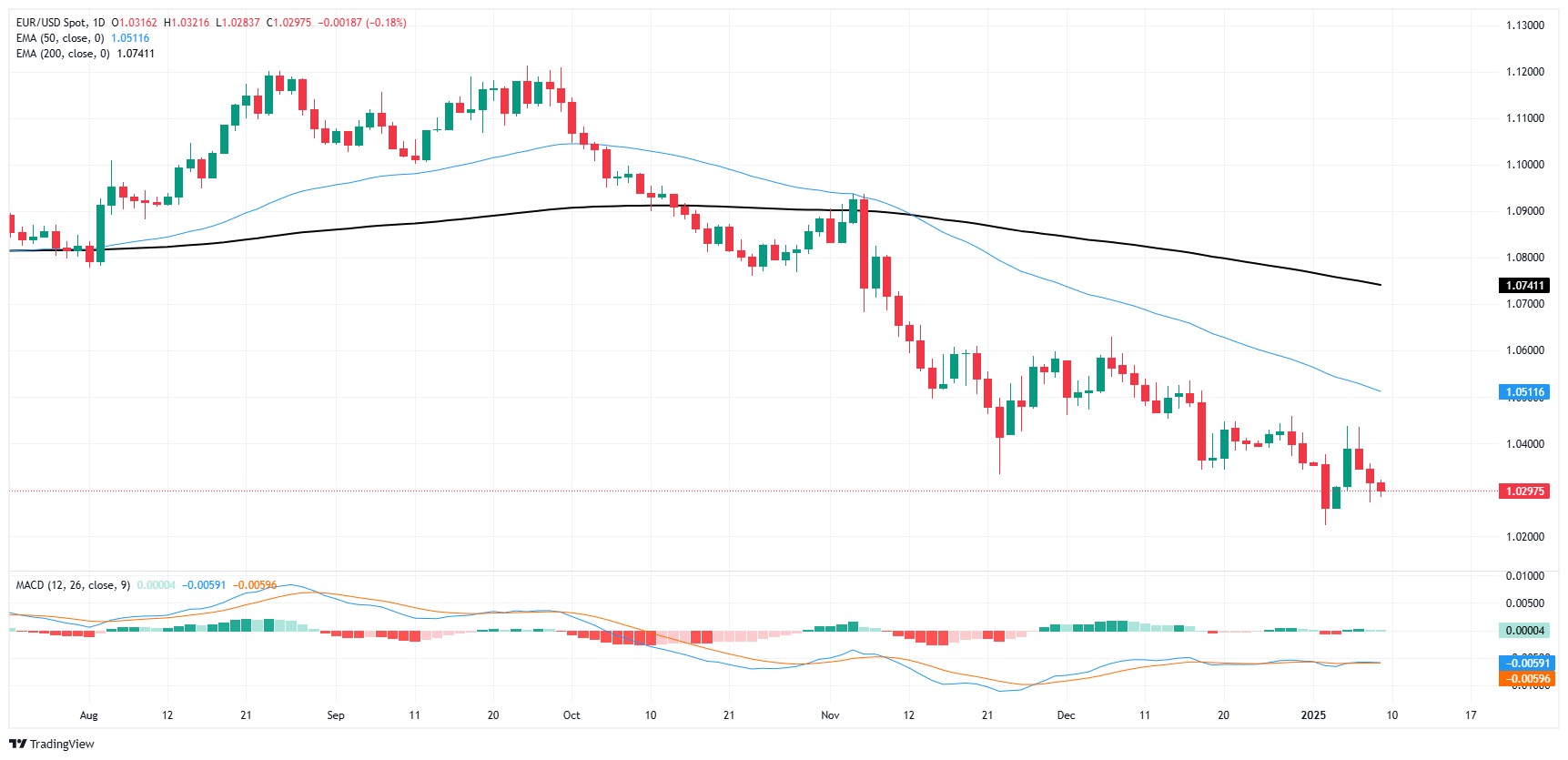- EUR/USD remains stuck to the 1.0300 handle after flubbing 1.0400.
- EU data is done for the week, but a key US NFP print still lies ahead.
- US net jobs additions are expected to ease back in December.
EUR/USD trimmed further into the bearish side on Thursday, falling back a scant but persistent sixth of a percent and keeping bids nailed to the 1.0300 handle as the pair churns near 26-month lows.
European Retail Sales figures missed expectations in November, hobbling any potential bullish Euro momentum heading into Friday’s US Nonfarm Payrolls (NFP) print. Annualized EU Retail Sales slumped to just 1.2% YoY in December, well below November’s revised print of 2.1%.
American markets were dark on Thursday in a day of mourning in observance of the passing of former President Jimmy Carter, who passed away in December at the age of 100. Market participants got a reprieve from the week’s hectic US data release schedule, but another round of Friday NFP jobs figures is looming ahead, further constraining already tight market volumes. US job additions are expected to ease slightly in December, while wage growth is forecast to hold on the flat side and even ease in the monthly figures. Beats in wage and job growth could spell further chaos for broad-market rate cut hopes looking forward to 2025, as high wages keep inflation expectations on the high end. Still, strong employment figures mean the Federal Reserve (Fed) will have little reason to move policy rates.
EUR/USD price forecast
January just started, but Fiber is already on pace to close a fourth consecutive month in the red as the pair kicks the new trading off with a fresh bearish plunge into its lowest bids in over two years. The Euro has fallen sharply against the US Dollar since a bearish rejection from the 200-day Exponential Moving Average (EMA) near the 1.0900 region back in November. EUR/USD fell a little over 6.5% peak-to-trough, and Euro bulls are struggling to find a fresh foothold.
EUR/USD daily chart
Euro FAQs
The Euro is the currency for the 19 European Union countries that belong to the Eurozone. It is the second most heavily traded currency in the world behind the US Dollar. In 2022, it accounted for 31% of all foreign exchange transactions, with an average daily turnover of over $2.2 trillion a day. EUR/USD is the most heavily traded currency pair in the world, accounting for an estimated 30% off all transactions, followed by EUR/JPY (4%), EUR/GBP (3%) and EUR/AUD (2%).
The European Central Bank (ECB) in Frankfurt, Germany, is the reserve bank for the Eurozone. The ECB sets interest rates and manages monetary policy. The ECB’s primary mandate is to maintain price stability, which means either controlling inflation or stimulating growth. Its primary tool is the raising or lowering of interest rates. Relatively high interest rates – or the expectation of higher rates – will usually benefit the Euro and vice versa. The ECB Governing Council makes monetary policy decisions at meetings held eight times a year. Decisions are made by heads of the Eurozone national banks and six permanent members, including the President of the ECB, Christine Lagarde.
Eurozone inflation data, measured by the Harmonized Index of Consumer Prices (HICP), is an important econometric for the Euro. If inflation rises more than expected, especially if above the ECB’s 2% target, it obliges the ECB to raise interest rates to bring it back under control. Relatively high interest rates compared to its counterparts will usually benefit the Euro, as it makes the region more attractive as a place for global investors to park their money.
Data releases gauge the health of the economy and can impact on the Euro. Indicators such as GDP, Manufacturing and Services PMIs, employment, and consumer sentiment surveys can all influence the direction of the single currency. A strong economy is good for the Euro. Not only does it attract more foreign investment but it may encourage the ECB to put up interest rates, which will directly strengthen the Euro. Otherwise, if economic data is weak, the Euro is likely to fall. Economic data for the four largest economies in the euro area (Germany, France, Italy and Spain) are especially significant, as they account for 75% of the Eurozone’s economy.
Another significant data release for the Euro is the Trade Balance. This indicator measures the difference between what a country earns from its exports and what it spends on imports over a given period. If a country produces highly sought after exports then its currency will gain in value purely from the extra demand created from foreign buyers seeking to purchase these goods. Therefore, a positive net Trade Balance strengthens a currency and vice versa for a negative balance.
Information on these pages contains forward-looking statements that involve risks and uncertainties. Markets and instruments profiled on this page are for informational purposes only and should not in any way come across as a recommendation to buy or sell in these assets. You should do your own thorough research before making any investment decisions. FXStreet does not in any way guarantee that this information is free from mistakes, errors, or material misstatements. It also does not guarantee that this information is of a timely nature. Investing in Open Markets involves a great deal of risk, including the loss of all or a portion of your investment, as well as emotional distress. All risks, losses and costs associated with investing, including total loss of principal, are your responsibility. The views and opinions expressed in this article are those of the authors and do not necessarily reflect the official policy or position of FXStreet nor its advertisers. The author will not be held responsible for information that is found at the end of links posted on this page.
If not otherwise explicitly mentioned in the body of the article, at the time of writing, the author has no position in any stock mentioned in this article and no business relationship with any company mentioned. The author has not received compensation for writing this article, other than from FXStreet.
FXStreet and the author do not provide personalized recommendations. The author makes no representations as to the accuracy, completeness, or suitability of this information. FXStreet and the author will not be liable for any errors, omissions or any losses, injuries or damages arising from this information and its display or use. Errors and omissions excepted.
The author and FXStreet are not registered investment advisors and nothing in this article is intended to be investment advice.
Recommended content
Editors’ Picks

EUR/USD holds lower ground below 1.0300 as traders await US NFP
EUR/USD holds lower ground below 1.0300 in European trading hours on Friday. Concerns over US President-elect Trump's policies and hawkish Fed expectations favor the US Dollar ahead of the critical US Nonfarm Payrolls data release.

GBP/USD falls back below 1.2300, US NFP eyed
GBP/USD is falling back below 1.2300 in the European morning on Friday, failing to sustain the rebound. The pair remains vulnerable amid persistent US Dollat strength and the UK bond market turmoil. The focus now shifts to the US labor market data for fresh trading directives.

Gold price sticks to intraday gains near multi-week top; US NFP in focus
Gold price attracts buyers for the fourth straight day on Friday amid some haven flows. The Fed’s hawkish stance, elevated US bond yields and a bullish USD should cap gains. Traders might also opt to wait for the release of the key US NFP report later this Friday.

Nonfarm Payrolls forecast: US December job gains set to decline sharply from November
US Nonfarm Payrolls are expected to rise by 160K in December after jumping by 227K in November. US jobs data is set to rock the US Dollar after hawkish Fed Minutes published on Wednesday.

How to trade NFP, one of the most volatile events Premium
NFP is the acronym for Nonfarm Payrolls, arguably the most important economic data release in the world. The indicator, which provides a comprehensive snapshot of the health of the US labor market, is typically published on the first Friday of each month.

Best Forex Brokers with Low Spreads
VERIFIED Low spreads are crucial for reducing trading costs. Explore top Forex brokers offering competitive spreads and high leverage. Compare options for EUR/USD, GBP/USD, USD/JPY, and Gold.